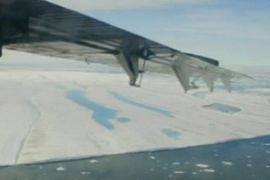Ice breaks off Canada Arctic shelf
Chunks measuring almost 20 sq km split off ice shelf, the biggest in three years.

The two sections measure four to 5 sq km and 14 sq km, officials said.
Ongoing break-up
The break-up was the largest of an ice shelf in the Arctic since the Ayles Ice Shelf split off Ellesmere Island in 2005 and formed about 66 sq km in size, or roughly the size of New York city’s Manhattan district.
Five vast ice shelves sit on the north side of Ellesmere Island in Canada’s Nunavut territory.
Ward Hunt is considered the largest, with a surface area of 443 sq km.
The ice shelves, vast plateaus of thick ice floating on the ocean but attached to land, began to form more than 4,000 years ago, scientists say.
“We ascertained that in the 20th century 90 per cent of the ice surface area [in the region] has been lost,” said Derek Mueller, a Polar specialist at Trent University in Peterborough.
“So, this phenomena has been ongoing on for a long time, but we’re now seeing punctuated events,” he said.
A fissure formed at the centre of the Ward Hunt Ice Shelf in 2002, leaving just a small amount of ice connected to Ellesmere Island.
A new crack measuring 18km long and 40m deep was discovered earlier this year.